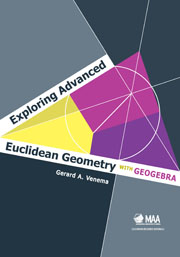Book contents
- Frontmatter
- Preface
- Contents
- 0 A Quick Review of Elementary Euclidean Geometry
- 1 The Elements of GeoGebra
- 2 The Classical Triangle Centers
- 3 Advanced Techniques in GeoGebra
- 4 Circumscribed, Inscribed, and Escribed Circles
- 5 The Medial and Orthic Triangles
- 6 Quadrilaterals
- 7 The Nine-Point Circle
- 8 Ceva's Theorem
- 9 The Theorem of Menelaus
- 10 Circles and Lines
- 11 Applications of the Theorem of Menelaus
- 12 Additional Topics in Triangle Geometry
- 13 Inversions in Circles
- 14 The Poincaré Disk
- References
- Index
- About the Author
9 - The Theorem of Menelaus
- Frontmatter
- Preface
- Contents
- 0 A Quick Review of Elementary Euclidean Geometry
- 1 The Elements of GeoGebra
- 2 The Classical Triangle Centers
- 3 Advanced Techniques in GeoGebra
- 4 Circumscribed, Inscribed, and Escribed Circles
- 5 The Medial and Orthic Triangles
- 6 Quadrilaterals
- 7 The Nine-Point Circle
- 8 Ceva's Theorem
- 9 The Theorem of Menelaus
- 10 Circles and Lines
- 11 Applications of the Theorem of Menelaus
- 12 Additional Topics in Triangle Geometry
- 13 Inversions in Circles
- 14 The Poincaré Disk
- References
- Index
- About the Author
Summary
The theorem we study next is ancient, dating fromabout the year AD 100. It was originally discovered by Menelaus of Alexandria (70–130), but it did not become well known until it was rediscovered by Ceva in the seventeenth century. The theorem is powerful and has many interesting applications, some of which will be explored in later chapters.
Duality
In the last chapter we studied the problem of determining when three lines through the vertices of a triangle are concurrent. In this chapter we study the problem of determining when three points on the sidelines of a triangle are collinear. The relationship between the two problems is an example of duality. Before studying the main result of the chapter we will pause to consider the principle of duality because discerning larger patterns such as duality can lead to a deeper understanding of the theorems of geometry than studying each geometric result in isolation.
Roughly speaking, the principle of duality asserts that any true statement in geometry should remain true when the words point and line are interchanged. Just as two points lie on exactly one line, so two lines intersect in exactly one point; just as three points may be collinear, so three lines may be concurrent. The use of the term incident makes these statements even more symmetric. For example, two distinct points are incident with exactly one line and two distinct lines are (usually) incident with exactly one point.
- Type
- Chapter
- Information
- Exploring Advanced Euclidean Geometry with GeoGebra , pp. 77 - 80Publisher: Mathematical Association of AmericaPrint publication year: 2013



